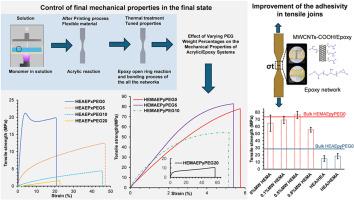通过碳纳米管增强关节性能的可调双固化丙烯酸/环氧树脂3D打印系统
IF 4.5
2区 化学
Q2 POLYMER SCIENCE
引用次数: 0
摘要
本研究提出了一种用于低粘度高性能丙烯酸/环氧树脂体系的新型双固化策略,该策略可以精确控制共网结构的最终密度及其热机械性能。与传统的丙烯酸酯/环氧双固化体系不同,这种新策略将长链扩展剂(聚乙二醇)共价键合在环氧网络中,以降低第二阶段固化时的交联密度。这允许对材料的机械性能进行微调,便于将弹性模量从3 MPa调整到2500 MPa,并实现80 MPa的最大抗拉强度值,同时保持低于35 MPa·s的低粘度,使其成为3D打印容器光聚合应用的理想选择。此外,该材料具有良好的热稳定性和优异的印刷元件分辨率,从而为实现与机械偏好和精确几何精度相关的最佳配置提供了广泛的设计选择。这项工作还包括粘合接头的抗拉强度分析,这是结构设计中的一个关键参数,特别是对于通过粘合制造大型部件。此外,该项目提出加入功能化多壁碳纳米管(MWCNT-COOH)以增强相之间的界面粘附。本文章由计算机程序翻译,如有差异,请以英文原文为准。


Tunable dual-curing acrylic/epoxy systems for 3D printing with enhanced joint performance via carbon nanotubes
This study presents a novel dual-curing strategy for low-viscosity, high-performance acrylic/epoxy systems, which enables precise control over the final density of the co-network structure and its thermo-mechanical properties. Unlike conventional acrylate/epoxy dual-curing systems, this new strategy incorporates a long chain extender (polyethylene glycol) covalently bonded within the epoxy network to specifically reduce the crosslinking density achieved in the second curing stage. This allows for fine-tuning of the material's mechanical properties, facilitating adjustments to the elastic modulus from 3 MPa to 2500 MPa and achieving maximum tensile strength values of 80 MPa, while maintaining a low viscosity of less than 35 mPa s, making it ideal for 3D printing vat photopolymerization applications. Additionally, the material exhibits good thermal stability and excellent printed components resolution, thereby opening a wide range of design options for achieving optimal configurations related to mechanical preferences and precise geometric accuracy. The work further includes an analysis of tensile strength in bonded joints, which is a crucial parameter in structural design, particularly for the fabrication of large parts through bonding. Moreover, the project proposes the incorporation of functionalized multi-walled carbon nanotubes (MWCNT-COOH) to enhance interfacial adhesion between phases.
求助全文
通过发布文献求助,成功后即可免费获取论文全文。
去求助
来源期刊

Polymer
化学-高分子科学
CiteScore
7.90
自引率
8.70%
发文量
959
审稿时长
32 days
期刊介绍:
Polymer is an interdisciplinary journal dedicated to publishing innovative and significant advances in Polymer Physics, Chemistry and Technology. We welcome submissions on polymer hybrids, nanocomposites, characterisation and self-assembly. Polymer also publishes work on the technological application of polymers in energy and optoelectronics.
The main scope is covered but not limited to the following core areas:
Polymer Materials
Nanocomposites and hybrid nanomaterials
Polymer blends, films, fibres, networks and porous materials
Physical Characterization
Characterisation, modelling and simulation* of molecular and materials properties in bulk, solution, and thin films
Polymer Engineering
Advanced multiscale processing methods
Polymer Synthesis, Modification and Self-assembly
Including designer polymer architectures, mechanisms and kinetics, and supramolecular polymerization
Technological Applications
Polymers for energy generation and storage
Polymer membranes for separation technology
Polymers for opto- and microelectronics.
 求助内容:
求助内容: 应助结果提醒方式:
应助结果提醒方式:


